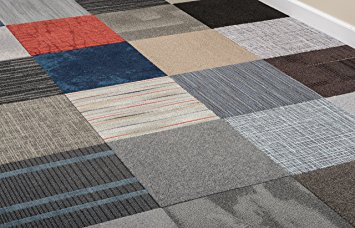Carpet tiles
Carpet tiles, also known as carpet squares, are a type of flooring which can be used as an alternative to the more common rolled carpet. They are formed from an upper layer of pile attached to a backing and are produced in a variety of sizes, materials, fibres, patterns and colours. Carpet tiles are often used in commercial and public buildings such as airports, offices, schools, libraries, and so on.
For the different types of carpet fibers, see Types of carpet.
Carpet tiles are manufactured in both non-adhesive (require gluing) and adhesive (peel-and-stick) styles.
When choosing tiles, it is important to consider the overall design scheme and the requirements of the finished floor, as well as the size and durability of the tiles required.
Some of the benefits of using carpet tiles include:
- They can be easier to install than rolled carpet.
- They can be installed over many floor types, including timber and concrete.
- Individual tiles can be removed and replaced for cleaning or if they get damaged.
- Creative patterned designs can be achieved.
- Many tiles are manufactured with good stain resistant properties.
Some of the drawbacks of using carpet tiles include:
- The seams of the tiles are more visible than rolled carpet and so require careful installation to avoid an uneven appearance.
- They can have a 'corporate' or 'municipal' feel.
- They can become unstuck, and curling or lifting at edges can create a trip hazard.
- They can be more difficult to remove than rolled carpet, which can be easily lifted.
- They can make access to under-floor services more difficult.
- They are generally not suitable for areas where they may be exposed to moisture.
- They can be more expensive than rolled carpet.
[edit] Related articles on Designing Buildings Wiki
Featured articles and news
RTPI leader to become new CIOB Chief Executive Officer
Dr Victoria Hills MRTPI, FICE to take over after Caroline Gumble’s departure.
Social and affordable housing, a long term plan for delivery
The “Delivering a Decade of Renewal for Social and Affordable Housing” strategy sets out future path.
A change to adoptive architecture
Effects of global weather warming on architectural detailing, material choice and human interaction.
The proposed publicly owned and backed subsidiary of Homes England, to facilitate new homes.
How big is the problem and what can we do to mitigate the effects?
Overheating guidance and tools for building designers
A number of cool guides to help with the heat.
The UK's Modern Industrial Strategy: A 10 year plan
Previous consultation criticism, current key elements and general support with some persisting reservations.
Building Safety Regulator reforms
New roles, new staff and a new fast track service pave the way for a single construction regulator.
Architectural Technologist CPDs and Communications
CIAT CPD… and how you can do it!
Cooling centres and cool spaces
Managing extreme heat in cities by directing the public to places for heat stress relief and water sources.
Winter gardens: A brief history and warm variations
Extending the season with glass in different forms and terms.
Restoring Great Yarmouth's Winter Gardens
Transforming one of the least sustainable constructions imaginable.
Construction Skills Mission Board launch sector drive
Newly formed government and industry collaboration set strategy for recruiting an additional 100,000 construction workers a year.
New Architects Code comes into effect in September 2025
ARB Architects Code of Conduct and Practice available with ongoing consultation regarding guidance.
Welsh Skills Body (Medr) launches ambitious plan
The new skills body brings together funding and regulation of tertiary education and research for the devolved nation.
Paul Gandy FCIOB announced as next CIOB President
Former Tilbury Douglas CEO takes helm.
UK Infrastructure: A 10 Year Strategy. In brief with reactions
With the National Infrastructure and Service Transformation Authority (NISTA).























